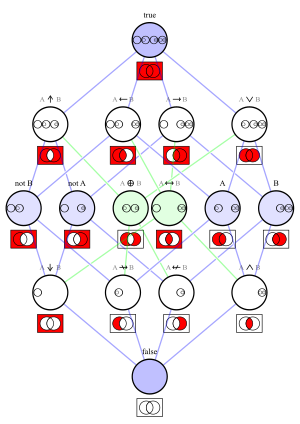
A | B | C | D | E | F | G | H | CH | I | J | K | L | M | N | O | P | Q | R | S | T | U | V | W | X | Y | Z | 0 | 1 | 2 | 3 | 4 | 5 | 6 | 7 | 8 | 9
| Logical connectives | ||||||||||||||||||||||
|---|---|---|---|---|---|---|---|---|---|---|---|---|---|---|---|---|---|---|---|---|---|---|
|
||||||||||||||||||||||
| Related concepts | ||||||||||||||||||||||
| Applications | ||||||||||||||||||||||
|
| ||||||||||||||||||||||

In logic, a logical connective (also called a logical operator, sentential connective, or sentential operator) is a logical constant. Connectives can be used to connect logical formulas. For instance in the syntax of propositional logic, the binary connective can be used to join the two atomic formulas and , rendering the complex formula .
Common connectives include negation, disjunction, conjunction, implication, and equivalence. In standard systems of classical logic, these connectives are interpreted as truth functions, though they receive a variety of alternative interpretations in nonclassical logics. Their classical interpretations are similar to the meanings of natural language expressions such as English "not", "or", "and", and "if", but not identical. Discrepancies between natural language connectives and those of classical logic have motivated nonclassical approaches to natural language meaning as well as approaches which pair a classical compositional semantics with a robust pragmatics.
A logical connective is similar to, but not equivalent to, a syntax commonly used in programming languages called a conditional operator.[1][better source needed]
Overview
In formal languages, truth functions are represented by unambiguous symbols. This allows logical statements to not be understood in an ambiguous way. These symbols are called logical connectives, logical operators, propositional operators, or, in classical logic, truth-functional connectives. For the rules which allow new well-formed formulas to be constructed by joining other well-formed formulas using truth-functional connectives, see well-formed formula.
Logical connectives can be used to link zero or more statements, so one can speak about n-ary logical connectives. The boolean constants True and False can be thought of as zero-ary operators. Negation is a 1-ary connective, and so on.








































